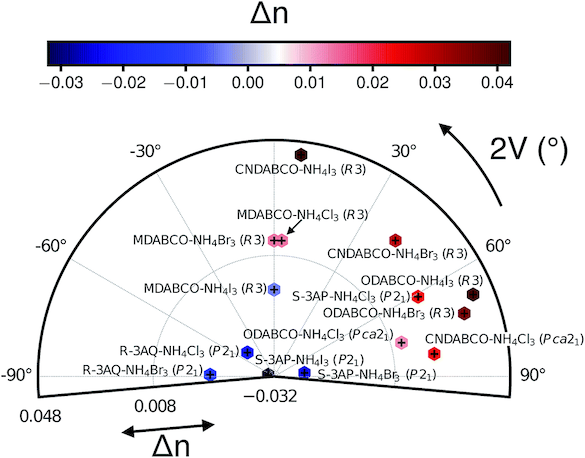Light has been utilized as a communication device for many centuries. Recently, non-linear optics (NLO) and second harmonic generation (SHG) have been at the heart of several technological revolutions. With the advent of the internet, conveying information and data by means of fiber-optics and lasers have transformed telecommunications. The development of fiber-optic devices with increased performance has fueled a surge of interest in the development of materials with ever-increasing data-transfer capabilities.
Materials, such as LiNbO3 and LiTaO3 with NLO and SHG are at the core of high-speed electro-optic modulator devices, significantly boosting the transmission capacities of the telecommunication infra-structure (~10 Gbit s-1).

Figure 1: Computed birefringence Δn and 2V angle of metal-free perovskite materials. More detail about this study can be found in Ref. [1]
The demand for apparatus with increased performance requires the development of novel inexpensive NLO materials and every year the electronic and telecommunication industries demands the production of $40.000 tons of LiNbO3. The soaring costs of lithium and niobium, and thus requires the development of the new generation of NLO materials relying on more earth-abundant elements.
Through computational materials science we unravel the complex mechanisms that maximize the interaction of light with advanced NLO materials. We use high-throughput techniques to discover novel NLO materials, as well as to unveil the structure properties relationship in novel SHG and NLO materials.
Relevant references
- P. A. Franken, A. E. Hill, C. W. Peters and G. Weinreich, Phys. Rev. Lett., 7, 118–119 (1971)
- T. W. Kasel, Z. Deng, A. M. Mroz, C. H. Hendon, K. T. Butler and P. Canepa, Chem. Sci., 10, 8187-8194 (2019)
- P. S. Halasyamani and K. R. Poeppelmeier, Chem. Mater. 10, 2753-2769 (1998).
- P. S. Halasyamani and J. M. Rondinelli, Nat. Commun., 9, 2972 (2018)
